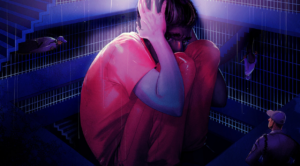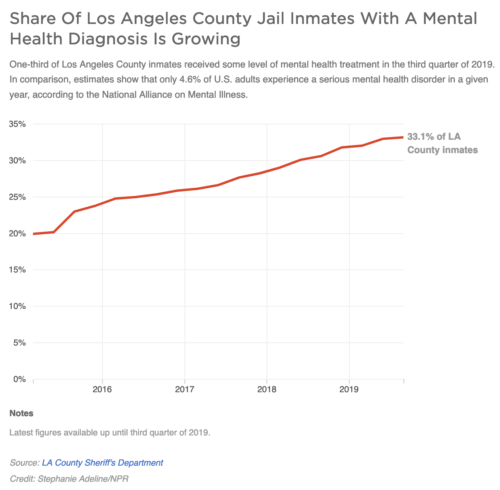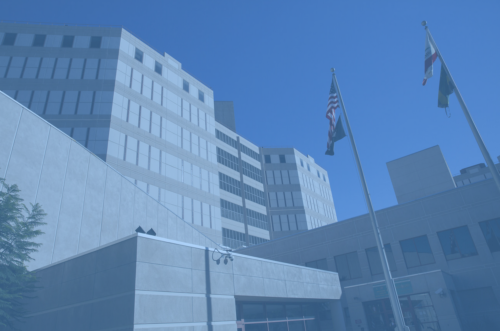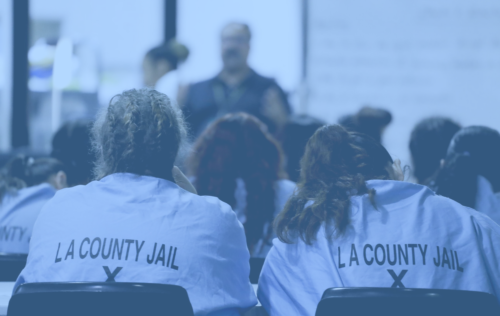
New inmates with a mental illness arrive daily in the Los Angeles County jail system. It now holds more than 5,000 inmates with a mental illness who’ve had run-ins with the law.
Zoë van Dijk for NPR
This is an issue in Canada (and the UK according to my friend, Mark, on Facebook).
America’s Mental Health Crisis Hidden Behind Bars
“Ten psychiatrist jobs have gone unfilled for two years.”
By Eric Westervelt and Liz Baker, NPR, February 25
https://www.npr.org/2020/02/25/805469776/americas-mental-health-crisis-hidden-behind-bars
It’s recreation time at a Los Angeles County jail known as the Twin Towers. Nearly a dozen disheveled young men stand docilely as they munch on sandwiches out of brown paper bags.
They’re half-naked except for sleeveless, thick, blanket-like restraints wrapped around them like medieval garments.
In Los Angeles, A Program To Get Those
With Mental Illness Away From Jails
All are chained and handcuffed to shiny metal tables bolted to the floor.
“It’s lunchtime and they’re actually [in] programming right now,” says a veteran guard, LA County Sheriff’s Deputy Myron Trimble.
Programming, in theory, means a treatment regimen. But it’s difficult to determine what treatment they’re actually receiving.
A whiteboard nearby tracks how many days since guards on this floor had to forcibly restrain anyone: 54. These inmates haven’t been violent, he says.
So why are all of the men shackled to tables for recreation?
“Just to make sure that they’re not walking around,” Trimble says. “If they don’t take their medications, they could be deemed unpredictable.”
No one is under the illusion that shackles are helping mentally ill inmates get well.
“I think everyone can agree that it’s rather inhumane to have the inmate handcuffed while out,” says LA Sheriff’s Capt. Tania Plunkett, with the Twin Towers’ Access to Care Bureau. “However, because of spacing and the lack of programming, we’re not able to really focus on getting the inmate better to eventually lead to having them in a program without being handcuffed.”
New inmates with a mental illness arrive daily in the LA County jail system. It now holds more than 5,000 inmates with a mental illness who’ve had run-ins with the law. Some 3,000 are held in the jail’s Twin Towers.
“By default, we have become the largest treatment facility in the country. And we’re a jail,” says Tim Belavich, the director of mental health for the Los Angeles County jail system. “I would say a jail facility is not the appropriate place to treat someone’s mental illness.”
In the past decade, the number of inmates housed at the Twin Towers has skyrocketed.

“When I started in 2013, mentally ill inmates were only housed on the seventh floor and the sixth floor right below it,” Capt. Plunkett says. “To date, the entire facility consists of mentally ill inmates.” (The adjacent Men’s Central Jail houses regular inmates.)
Across the country, there are dozens of places like Los Angeles’ Twin Towers, warehousing people in settings with inadequate staff, services and support.
It’s a culmination of decades of policies affecting those with a mental illness. Many of the nation’s asylums and hospitals were closed over the past 60-plus years — some horrific places that needed to be shuttered, others emptied to cut costs.
The idea was that they’d be replaced with community-based mental health care and supportive services. That didn’t happen. Ensuing decades saw tougher sentencing under aggressive “war on drugs and crime” policies as well as cuts to subsidized housing and mental health. It all created a perfect storm of failed policies driving more of the mentally ill into the nation’s jails and prisons.
Many were left to fend for themselves. Substance abuse and homelessness sometimes followed, as did encounters with police, who often are called first to help deal with the effects of or related to mental crises.
It has put the jails in an awkward position. Today the three biggest mental health centers in America are jails: LA County, Cook County, Ill. (Chicago) and New York City’s Rikers Island jail. Without the support needed, conditions have created new asylums, advocates say, that can resemble the very places they vowed to shut down.
“Local jails and prisons have become the de facto mental health institutions,” says Elizabeth Hancq, director of research at the Treatment Advocacy Center, a national nonprofit that works to eliminate barriers to treatment for people with severe mental illness. “It’s really a humanitarian crisis that if you suffer from a severe mental illness in this country, you almost need to commit a crime in order to get into the system.”
Almost one-third of people with a mental illness get into the treatment systems through an encounter with a police officer, studies show. The lack of available treatment beds nationally means more people with a mental illness are stuck in jails until one becomes available, often for painfully long periods.
It’s hard to quantify just how big the problem really is. No organization or agency keeps close nationwide tabs on the number of inmates in county and city jails who have a mental health problem or their average length of stay.
That has made it that much harder for experts and lawmakers to evaluate potential policy solutions to help fix this nationwide crisis.
“Without adequate and appropriate data collection and analysis on serious mental illness in our jails and prisons,” Hancq says, “there can’t be real accountability and oversight into what’s going on.”

The Los Angeles County Sheriff’s Department Twin Towers Correctional Facility stands in Los Angeles in 2014. Conditions for mentally ill inmates in Los Angeles County have been a focus of federal probes since 1997.
Patrick T. Fallon/Bloomberg via Getty Images
As The Atlantic recently reported, no one is carefully tracking how many people are held over the legal limit set in their state for being evaluated for mental competency or transferred to a state hospital once declared incompetent to stand trial.
Thousands of people who’ve been declared incompetent to stand trial and who need mental health treatment, the magazine reports, are today warehoused in jails for unconstitutionally long periods before they are convicted or even tried for any crime.
In LA, well over half the inmate population is awaiting trial or sentencing. For many living with a mental illness, even a day or two in jail following a breakdown can have horrendous long-term consequences. Studies show that brief jail stays for low-risk individuals with a mental illness can more than double recidivism rates.
“It demolishes them,” says Steve Leifman, a judge with Miami-Dade County’s 11th Judicial Circuit. An expert on the topic, Leifman has worked for more than two decades to reform how the justice system treats people with mental health problems.
“They are cut off. Most of these people have very serious trauma issues. If they have housing, they’re going to lose it. If they have a job, a day off is a big, big problem.” The nation’s mental health system today, Leifman says, “is not only fundamentally broken, it’s cruel and unusual.”
Can’t get well in a cell?
LA’s Twin Towers jail was not built for treatment. There are no group rooms, no confidential spaces, really no privacy.
It doesn’t have enough counselors. Ten psychiatrist jobs have gone unfilled for two years.
“We used to have a psychiatrist see [the more acute patients] every two weeks,” says social worker Luis Peña, the jail’s mental health clinical program manager. “But because of the lack of psychiatrists in the jail, we have to see them [once] every month.”
If lucky, the inmates on this floor will see a social worker once a week.
The jail needs about 200 inpatient treatment beds for acute cases, officials here say. It has only about 40 to 50 available daily.
“We have more than 140 individuals on any given day who could use an inpatient bed that we just cannot provide at the moment,” Belavich says.
By default, there’s more of an emphasis on medication — critics say over-medication — and less on individual or group therapy. There’s really no room for that. On several floors, bunk beds and makeshift living areas pack what should be “common use” areas.
“We have to scramble. We have to do whatever we need to do,” social worker Peña says, “whether the individual is suffering from schizophrenia, psychosis, provoked by drugs or whatever, this is population that we get, the population that we need to target to provide the best that we can.”
Outside the cells there’s a ready supply of suicide restraints. They are heavy beltless garments with Velcro, akin to the thick blankets movers use, and are stacked on shelves like office supplies.
Along one cellblock, an inmate gestures frantically at a small window. He has carefully piled garbage in a corner of his cell, like some grim abstract sculpture. A door note warns guards that he’s “a runner.”
There are other notes on other doors. One inmate is deemed “hostile.” Another, “suicidal.” And guards track on boards who’s a “gasser” — meaning an inmate who has thrown blood, urine or feces.
There’s often a smell of urine and dank water. In several areas toilet water is seeping out of cells.
“Looks like he clogged the toilet and continued to flush it, which resulted in it overflowing,” Capt. Plunkett says, pointing to an inmate who is known to act out.
“Unfortunately, with the design build, drains weren’t incorporated. So it will collect water, sometimes an extensive amount of water, on the floor.”
Cell flooding, guards say, is a daily occurrence.
Despite the major strains, the jail tries to find creative workarounds, says Belavich, the mental health director. He introduced new programs specifically aimed at the most severely mentally ill, but concedes significant hurdles remain.
“We continue to try to address those challenges,” he says. “However, without certain resources, we won’t be fully successful.”

Inmates listen during a program at the Twin Towers Correctional Facility on April 27, 2017, in Los Angeles. In the past decade, the number of inmates housed here has skyrocketed. Chris Carlson/AP
Over the years, the Los Angeles County jail has been forced to address the treatment and reduce the criminalization of people living with a mental illness.
Most action was spurred by lawsuits and subsequent court settlements including the landmark Rosas decision. That legal case, which centered on accusations of abuse and beatings by guards throughout the county’s jail system, led to court-appointed monitors to improve civilian oversight and better training.
Reported use-of-force incidents are down since Rosas. Security conditions are better, “but compared to what?” asks staff attorney Sarah Clifton with the ACLU of Los Angeles. She monitors the Twin Towers as the group’s jails policy and conditions coordinator.
“A lot of times in jail settings, you’ll see improvement in one area and then backsliding in another. And I think one of our biggest goals is to avoid backsliding” on use of force and treatment shortcomings, Clifton says. “We are pushing for more community treatment, a decentralization of care and not using the jails as warehouses for people with mental health issues.”
That’s what activist and artist Patrisse Cullors wants, too. She founded the group Reform LA Jails and helped co-found Black Lives Matter. Her older brother was diagnosed with schizoaffective disorder, mania and depression. It’s led to many encounters with the criminal justice system.
“The first time I saw my brother in the [L.A] county jail system he was in terrible condition,” Cullors says. “And I just kept thinking — why would our society allow for someone who’s sick to be treated this way, to not be given the kind of care they deserve?”
During one manic episode more than a decade ago, her brother took off in his mother’s car. He ended up in a high-speed chase and was arrested for fleeing the scene.
In LA’s north detention center, Cullors says, he was beaten by guards while experiencing psychosis. Later, during her brother’s time in the Twin Towers, she says, his condition only worsened. “They need to be in adequate mental health facilities. We have a slogan in our campaign — you can’t get well in a cell.”
Last year, LA County Supervisors finally agreed. Under public pressure, they scrapped a $1.7 billion plan to build a jail-like mental health center partially on the site of the current Men’s Central Jail complex where the Twin Towers sit.
Critics called it a rebranded jail that would continue to criminalize people living with a mental illness.
“I don’t know how anybody gets well in there,” says LA’s District Attorney Jackie Lacey, who has supported efforts to find alternatives to the Twin Towers. “It’s noisy, it smells terrible, even when you’re meeting with your mental health professional you’re chained to a bench. There are people swirling all around you, some of them are rocking back and forth and talking to themselves.”
Lacey, who’s running for re-election, has pushed to expand community-based mental health treatment and housing through a special diversion court. It aims to stop mentally ill homeless people cycling through jail, court and the streets.
“If you can release some of that pressure so that people aren’t doubled and tripled up in cells [in the Twin Towers] and you have people in a setting that’s truly therapeutic but safe for the public, that’s really something that all of us should support,” Lacey says.
Belavich welcomes that. “Many of these individuals [in the Twin Towers] may not need to stay with us at all or may be able to stay with us for a much shorter amount of time until we can stabilize them and find them resources in the community,” he says.
However, he warns, the county has a very long way to go. “If we are able to divert a lot of these individuals, we have to have some place to divert them to.”
Alternative court
On a recent morning LA Superior Court Judge Karla Kerlin is thankful for the day’s relatively light load — just three dozen files on her desk. On some days the stack obstructs her courtroom view. Kerlin oversees the city of LA’s diversion and reentry housing court.
“Who has the files on Barclay?” she asks, taking up the case of Angie Barclay, 57, whose long arrest history, according to court records, includes theft, narcotics possession and prostitution. And there’s her latest charge.
“Assault with a deadly weapon, in this case a knife, this is a felony, and a serious felony — which means it is a strike,” Kerlin tells Barclay.
Barclay sits stoically in the defendant’s chair in a blue jail jumpsuit. In any other courtroom, she would likely continue to cycle between jail and the streets.
But today, Judge Kerlin wants to try to end that pattern. She calls the courtroom psychiatrist to the bench for a sidebar talk.
“So her diagnosis is bipolar 1 disorder,” the psychiatrist tells her quietly. “She’s doing well, actually, a little blunted but improving.”
Barclay’s taking her medications, the psychiatrist adds.
Despite objections from the prosecutor, Kerlin decides to give Barclay a chance at the housing and treatment program. It’s a relatively new effort by the county to try to get more people with mental illness who are homeless diverted from jails and off the streets by funneling them into treatment and supportive housing.
The stakes are high: If the person successfully completes this two-year diversion program, his or her case will be dismissed. If not, the criminal case will be reinstated. If the person is kicked out or doesn’t finish, they don’t get “credit” for time served in the diversion program.
“All right Ms. Barclay,” Kerlin says loudly, moving swiftly through her case. “Just let me confirm that this is what you want to do because it’s a lot more extensive than being on regular probation. First, you would be conditionally released, which means you don’t just walk out of jail, someone comes and picks you up from jail and brings you to housing. You get housing!” Kerlin tells her.
There’s no strict lockdown, “but I want you there every night,” Kerlin says, adding that Barclay has to take all her medications and attend all her counseling sessions.
Barclay agrees to the terms with a firm but quiet “yes.”
“Any questions? OK, good luck to you. I hope it works out, OK?,” the judge says. “Welcome to the program!”
This is, right now, LA’s main plan B for reducing the population of mentally ill inmates in the Twin Towers. It’s the more humane alternative to warehousing people with a mental illness there.
But this diversion court and housing program is risky. Some in it have committed serious crimes that still need to be addressed.
“They’re mentally ill and not medicated, they come up on someone and whack them with a metal pole or something, that’s a very common fact pattern,” Kerlin says, sitting in her chambers after the morning’s session. “So it’s very dangerous.”
But Kerlin says she and the LA judicial system have to daily assess whether it’s safer and more effective to have these people in a fledgling program where they get housing and the treatment they need, or the cycle of jail likely followed by homelessness.
“Someday they’ll be released and back on the streets unmedicated,” Kerlin says. “So which is safer?”
Supportive housing
At a large house in a central LA neighborhood, some of the 22 men who live here are watching TV or just hanging out.
Nearly 80% of the people in this diversion and housing program are living with at least one serious mental health disorder. About 40% have both mental health and substance abuse disorders.
Here, treatment looks very different from the Twin Towers.
“Everybody is connected to a case manager and a therapist once they come in,” says the program’s housing director, Ryan Izell. The concept is simple, he says: humans need community, a home and — when ill — quality care. “There are clinicians and psychiatry on site, as well as nursing staff on site to provide support to people taking medication, as well as additional staff to just supply day-to-day support to make sure the house is operating well.”
There are no locked gates or guards at the door, only a binder for signing in and out.
“If someone chose to stop taking their medication, they could walk out,” says Lacey, the county’s district attorney. “But the good news is, that really only occurs in less than 20% of the cases we divert.”
And unlike the Twin Towers, the house has calm, quiet and privacy.
Halel Feldman, a 21-year-old who goes by Finn, is reading in his room. He has been in the program about a year.
Like all the men at this house, Finn was judged incompetent to stand trial. His felony charges include assault and vandalism.
At age 16, Finn says, he was diagnosed with schizophrenia. “I saw a lot of different visual hallucinations that really affected my day to day life. My head wouldn’t stop shaking. My head doesn’t shake anymore, thank God, because of the medication they have me on.”
Finn is getting, in the words of the court, “restored” to mental competency here instead of in a jail or a state hospital. If he continues to make progress, his pending criminal case will be dropped.
“I don’t go through the suicidal thoughts that I used to,” Finn says. “I don’t go through voices as much. Like, I’m in a very good headspace,” he says adding, “better than jail.”
Finn’s roommate is 19-year-old Craig Reid, who says he struggles with bipolar and obsessive compulsive disorder, and ADHD.
“When I first got here, I was a little wild,” Reid says.
Before entering this program, Reid was jailed on the upper floors of the Twin Towers, where the inmates with more severe mental health problems are mostly confined in cells under strict lockdown. There was limited treatment.
Now, Reid says, he feels better, more alive. “I’m a rap artist. I like poetry, I like to write.”
And Reid and Finn have become friends. “I read the book of Mormon with him,” Reid says, “and go to church with him sometimes.”
So far, the program shows promise. And it’s saving money. The county says jail costs almost five times more than this kind of inpatient housing. It also has, so far, a much lower recidivism rate than county jail.
The biggest challenge is scaling it up to meet the massive need. Most of the county’s diversion programs were launched four years ago. So far, these programs have helped transition more than 4,600 people from jail and into community services, including housing.
But remember there are currently more than 5,000 inmates identified with some type of mental illness now cycling in and out of LA’s county jail system.
“I think that the average person must see that something needs to change. It’s so apparent that the numbers are growing,” says psychiatrist Kristen Ochoa, the Office of Diversion and Reentry’s medical director.
ODR and the Rand Corp. did studies that suggest that nearly 60% of those behind bars with a mental illness could go to diversion court or similar nonjail alternatives.
“We think that more than half of them would be eligible for interventions that would release them from jail and put them into care and housing, if those services existed,” Ochoa says.
She says the county estimates they’d have to add at least 3,000 beds the first year alone to begin to start to meet that need. Ochoa and others say that will take more money and political will — but also more compassion.
Next month in its final report, the county’s Alternatives to Incarceration Work Group will call for expanding and scaling these kinds of housing and diversion programs, among other recommendations for increasing community-based care.
Judge Kerlin acknowledges the diversion program doesn’t work for everyone. She sometimes sees the same faces in her court. She sees some of them wipe out.
“I’m very disappointed when someone I know picks up a case or something happens or we’ve had a couple deaths, and it’s heartbreaking,” Kerlin says. “And there have been people I’ve had to terminate from the program as well, and that’s heartbreaking too.”
Then there are the successes, Kerlin says, “And they make you see that this can be done and is worthwhile. And people’s lives matter.”
I invoke the Halion Engineers, the Hathors,
Universal Law, Divine Blessings, Virtues,
and Dimensional Growth Patterns for
BALANCE in our prison systems.

THE SCALES OF JUSTICE, OF WORTH AND OF THE UNIVERSE, IN BALANCE

